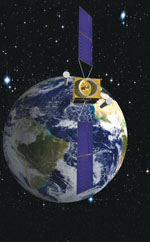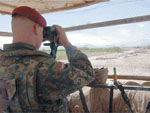Bundeswehr Launches Orbital Network
 |
| The SatcomBw program will provide the German military with its first dedicated military satellite communications system and ground infrastructure. |
Since the late 1990s, regional and global events have impelled European nations to deploy their forces abroad. A major contributor to NATO and European Union Rapid Reaction forces,
The SatcomBw program consists of a two-satellite constellation as well as fixed and mobile groundstations to provide the Bundeswehr with secure voice, data and video transmissions. The satellites will operate in geostationary orbit covering an area stretching from North America to eastern
Two types of groundstations will support the satellites. The first group are large, NATO-compatible transceiver stations capable of transmitting telephone calls, supporting radio relay services and providing Internet access and video services. These stations also will serve as nodes for in-theater mobile and fixed data networks. A second type of smaller, more portable terminal will enable the use of broadband services such as video and Internet access as well as access to the Bundeswehr’s internal information system.
Officially approved in July, the 10-year contract has an extension option for an additional seven and a half years. According to EADS Space Services spokesman Dr. Mathias Spude, the total cost for the program, including the military’s investment, is approximately 940 million euros, or nearly $1.2 billion.
The DLR will manage the satellite segment of the program, while the Bundeswehr operates the groundstations. Alcatel Alenia Space manufactured the two spacecraft—which feature a design based on the Spacebus platform—for EADS Astrium. Arianespace will launch the satellites from the
Initiated in the late 1990s, stage one of SatcomBw consisted of developing the ground infrastructure. ND Satcom built two anchor stations operating in the C, X and Ku bands; 16 transportable tri-band ground terminals with an operating bandwidth up to 6 megabits per second; and 26 single-channel ground terminals operating at 128 kilobits per second. The anchor stations are located at Gerolstien and Kastellaun. Both facilities will provide secure communications to German forces deployed overseas. The smaller terminals are designed for use on ships, aircraft and ground vehicles as well as in fixed and mobile sites.
The first phase included the development of a network management system and a secure intranet. According to ND SatCom officials, the company will manufacture and provide the complete ground segment: groundstations, telemetry, the tracking and command network, network management and system control. The firm also is providing the training and technical support services for the groundstations and terminals.
Stage two of SatcomBw consists of the in-orbit delivery of the satellites, the user terminals and the upgrade of the network management center that was built during the first stage. An unspecified number of manportable terminals will be purchased to support the program. MilSat Services GmbH will use Intelsat satellites to provide the Bundeswehr with an additional commercial-based transmission capacity.
EADS and ND SatCom formed Milsat Services GmbH as a limited liability company to manage and oversee the program. EADS Space Services owns 75 percent of the company, while ND SatCom owns 25 percent. Spude notes that the program’s contract language includes the procurement of the satellites, their delivery, the manufacture and operation of the ground facilities and the system’s overall operation and maintenance throughout the program’s 10-year life.
Besides providing the Bundeswehr with its own dedicated satellite communications system, SatcomBw also employs key German aerospace firms. “The important thing from an industrial policy point of view is that 60 percent of the entire contract volume is awarded to German companies,” Spude says.
Security policy is another important dimension of the program. SatcomBw is the first German-owned and -operated government satellite constellation. This has important implications for military and government policy as German forces begin to deploy globally to support NATO and other coalition operations.
 |
 |
| German forces are deploying overseas to support a variety of multinational and peacekeeping operations. With more troops abroad regularly, the Bundeswehr launched a program to provide units with secure communications links back to national headquarters in Germany. |
The program is indicative of the key role
Jones observes that
Because the Bundeswehr is orienting itself for low-intensity expeditionary missions, much of its procurement is directed at supporting these operations. With the notable exceptions of Eurofighter, A-400M transport aircraft and armored vehicle purchases,
Jones blames successive German governments for cutting the Bundeswehr’s funding since the end of the Cold War. Only in recent years have programs such as SatcomBw and Hercules sought to modernize the military’s command and control infrastructure. “In many ways across the board, they are notably behind the French and the British,” he says.
Web Resources
EADS Space Services: www.space.eads.net
ND SatCom: www.ndsatcom.com




Comments